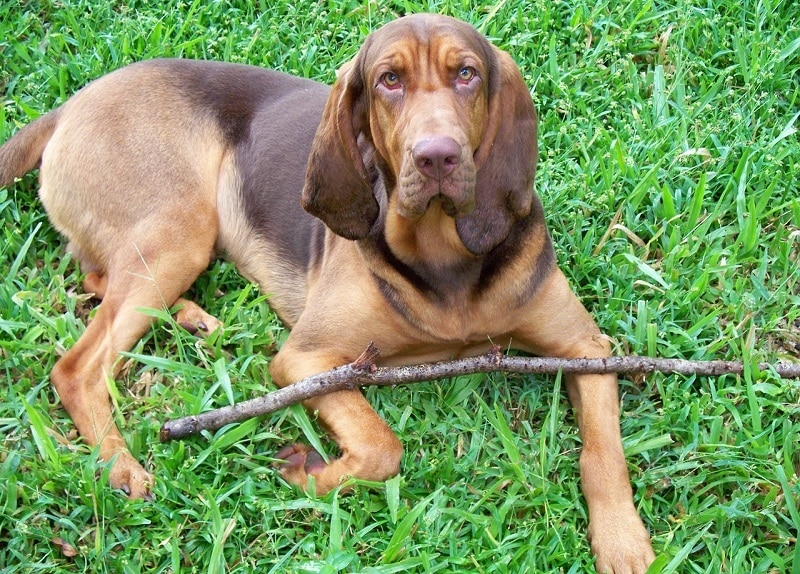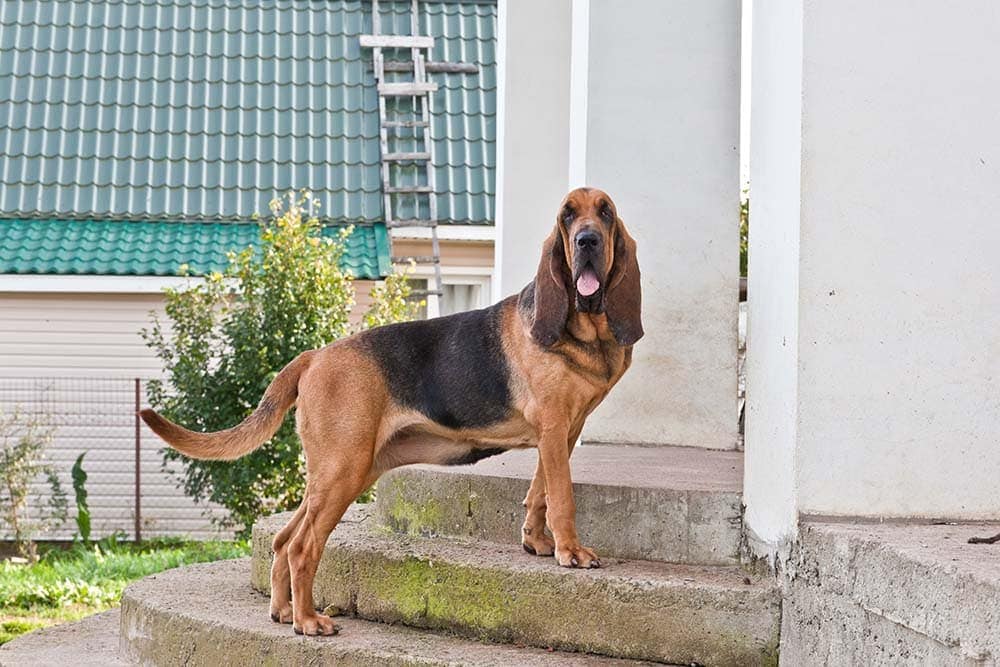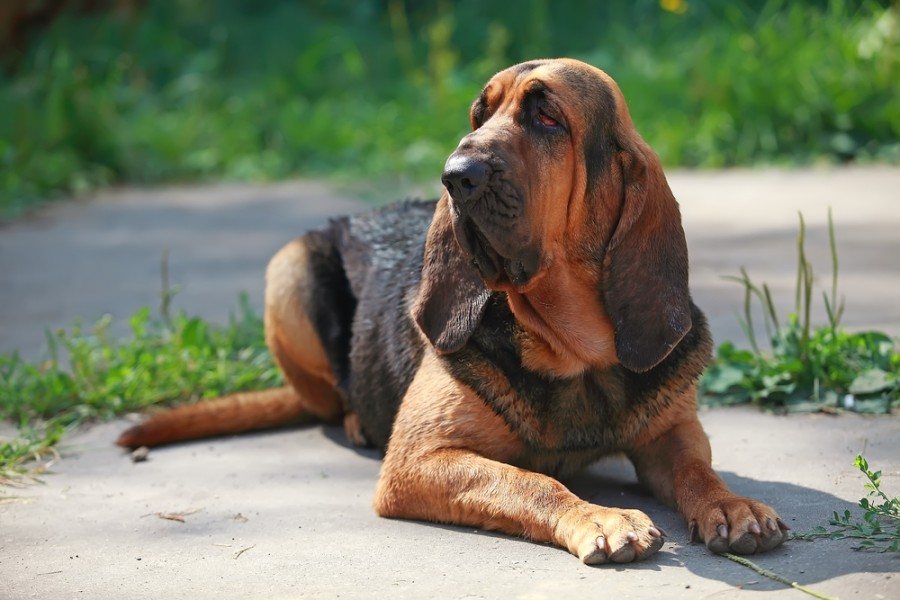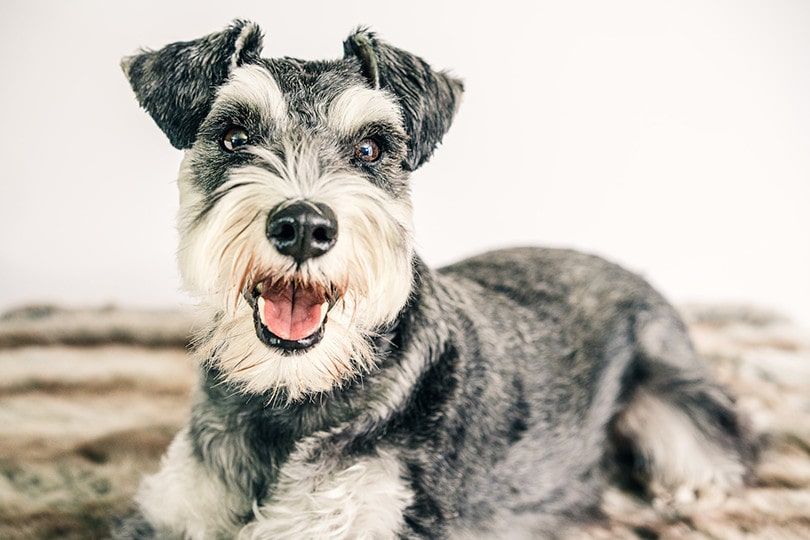Known for their amazing sense of smell and adorable wrinkled faces, Bloodhounds are a truly unique breed. No dog is perfect, and the Bloodhound has positive and negative traits like any breed. Here are 12 Bloodhound pros and cons you should know before deciding if this is the dog for you.

The 6 Bloodhound Pros
1. Good with Kids
Bloodhounds are typically excellent family dogs who do well with children despite their large size. Of course, it’s important to socialize Bloodhounds with kids from a young age and supervise interactions.
Most Bloodhounds are tolerant of the unpredictable behavior of kids, but they won’t necessarily join in energetic play. Bloodhounds are calm, social dogs who enjoy making new friends of all ages. They fit in well with busy families who frequently have strange children over to play.

2. Good with Other Dogs
Since they’re bred to work in packs, if necessary, Bloodhounds usually get along well with other dogs. Their size may be intimidating for smaller dogs, and you should supervise Bloodhounds when playing with them.
Early socialization will help ensure that Bloodhounds react calmly to new dogs. They may enjoy dog play dates for exercise and enrichment. Make sure off-leash play takes place in a safely fenced area so the Bloodhound doesn’t lead their canine friends on a hunt.
3. Amazing Sense of Smell
Bloodhounds are well-known for their amazing sense of smell. Their noses are such sensitive instruments that several courts have ruled that Bloodhound scent trails can be used as evidence in criminal cases.
The Bloodhound is an obvious match for dog owners interested in volunteer search-and-rescue or participating in tracking trials. They were born to use their nose, and tracking allows the Bloodhound to get physical and mental stimulation.

4. Easy to Groom
Bloodhounds have short coats and typically shed only moderately. Weekly brushing is usually enough to control shedding, but the frequency may need to increase during seasonal heavier hair loss. Besides brushing, Bloodhounds need their facial folds and wrinkles wiped daily to keep them clean and dry.
Their droopy ears should also be checked and cleaned regularly to prevent infection. Bloodhounds generally don’t need professional grooming unless it’s their owner’s preference. They usually tolerate grooming well, especially when a routine is introduced early.
5. Love to Cuddle
Bloodhounds may be tireless workers when they’re on the scent, but once they’ve found their target, they’re happy to take a break at home. They are affectionate, bond closely with their families, and are usually friendly
Image Credit: Anna Tronova, Shutterstock
to strangers when properly socialized.
Although they still need daily exercise, the gentle Bloodhound loves to cuddle when work and play are done. Just remember, if you don’t want your adult Bloodhound crowding you off the couch or out of your bed, keep the puppy’s feet on the floor. Independent Bloodhounds may still cuddle up beside you, but at least you tried.

6. They are Independent
This one is both a pro and a con. Bloodhounds were bred to track scents with limited assistance from human handlers, who were often left in the dust. Because of this, they needed the ability to think and act on their own.
Bloodhounds are independent dogs who don’t always prioritize what their owners want. This trait can make them challenging to train. However, it also makes them less needy or clingy than other breeds. Bloodhounds won’t necessarily dislike being left alone, although they can sometimes get bored and destructive.

The 6 Bloodhound Cons
1. They are Loud
Bloodhounds are one of the oldest scent hound breeds. They tend to be quite vocal when tracking and hunting, with a loud and distinct bay. While this baying may be helpful during hunting, it also makes the Bloodhound an unpleasant neighbor in close quarters.
This is not the breed for apartment living or even dense city neighborhoods. There may not be a good reason for the barking either since Bloodhounds are not natural watchdogs.

2. They Drool
Bloodhounds may not shed excessively but produce more drool than most other breeds. We already talked about how important it is to keep their face wrinkles dry to help prevent infection.
Constant drool can stain your furniture, clothes, and carpets. You can feel like you’re stuck in a never-ending cycle of wiping Bloodhound drool off surfaces and their faces. If you have a child who’s shorter than the Bloodhound, expect to find drool on their head at some point.
3. They Smell
Like many of their fellow hounds, Bloodhounds tend to be smelly. The Bloodhound’s odor can have many sources, whether the odor of a skin infection or the build-up of drool in their facial folds.
They are also prone to ear infections, which is another possible cause of odors. Since they’re fond of digging and exploring the outdoors, Bloodhounds can make quite a mess. Fortunately, a good grooming routine and regular bathing can help keep some of the odor at bay.

4. They are Stubborn
The Bloodhound’s refusal to give up when following a scent is one of their defining traits. However, that stubbornness is less desirable when you’re trying to train a Bloodhound. An independent nature combined with a stubborn streak can lead to frustration for inexperienced owners.
Bloodhounds are smart dogs, but just because they can learn doesn’t mean they’ll do it willingly. Patience and plenty of food rewards are your best tools to overcome the Bloodhound’s natural stubbornness.
5. They Can’t Be Trusted Off-Leash
Like most hounds, Bloodhounds will follow their noses wherever they lead. Because of that, they can’t be trusted to play off-leash outside of a fenced area. One whiff of an intriguing scent and even a well-trained Bloodhound may completely ignore your commands.
Keep your pet leashed on walks, hikes, and jogs. The powerful Bloodhound may be too much for kids or the elderly to walk alone. Make sure your Bloodhound has proper identification, including a registered microchip, in case they wind up far from home.

6. They are Prone to Some Health Issues
Like other large, deep-chested breeds, Bloodhounds are prone to bloat, a life-threatening condition where the stomach expands and twists, trapping gas and fluid. Bloodhounds can also inherit hip and elbow dysplasia.
They can suffer from genetic heart conditions as well. When researching potential Bloodhound breeders, look for one who performs the required health screenings on their dogs. Ask about the medical history of your puppy before agreeing to the purchase.

Conclusion
Currently, Bloodhounds are ranked 50 out of 200 AKC-recognized breeds in terms of popularity. They aren’t the most common breed, but they aren’t rare, either. Based on these numbers, it’s clear that plenty of dog owners feel that the pros of the Bloodhound outweigh the cons.
Our Bloodhound pros and cons aren’t meant to persuade you one way or the other but simply to present the facts. Bloodhounds can make affectionate pets for the right family, but they aren’t for everyone.
Featured Image Credit: Degtyaryov Andrey, Shutterstock



